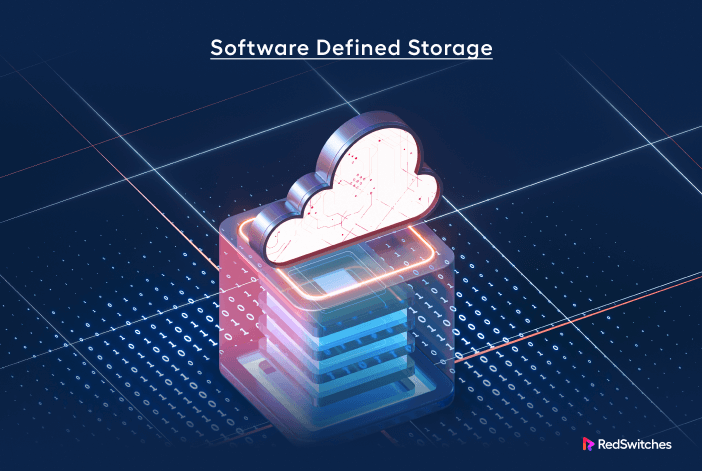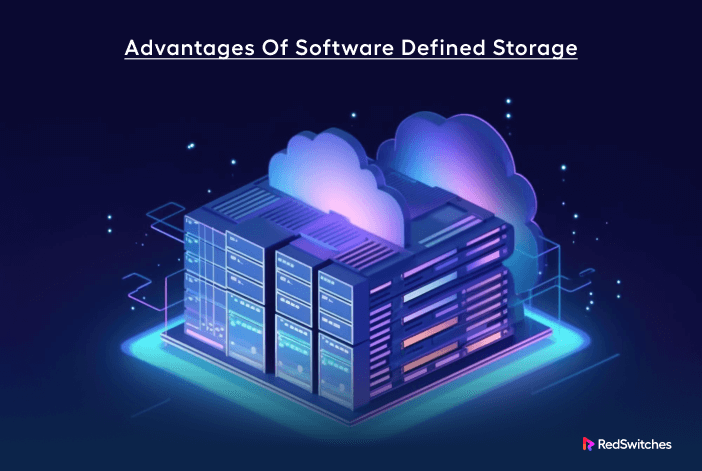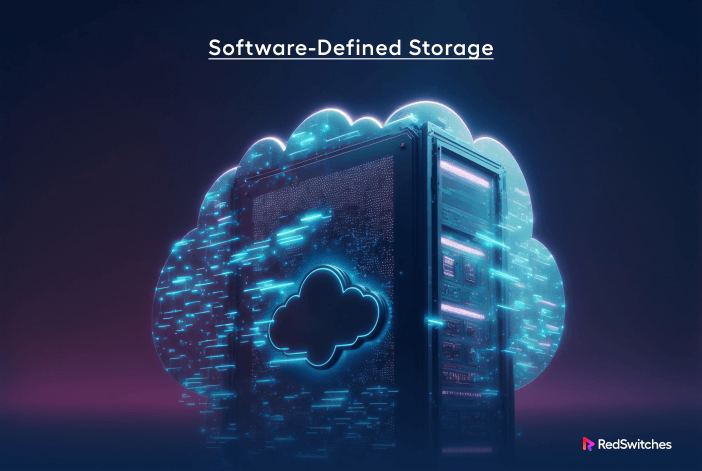Storage is perhaps the most cost-effective aspect of any hosting solution. That’s why many users check the technology (SSD or NVMe) and then go on to other features such as CPU and RAM.
However, various business processes need to store and access a massive volume of data, and local storage devices are often inadequate for this purpose. At the same time, businesses need to work with storage solutions that aren’t directly connected to the local network.
Virtualization of storage components (also known as Software Defined Storage (SDS) is a great solution that solves these two challenges in one go. The storage resources are virtualized and isolated from the underlying server hardware. As a result, businesses experience unmatched flexibility, scalability, and efficiency.
In this introductory article, we’ll discuss the idea of Software Defined Storage in detail. We’ll closely examine the architecture of SDS, its critical features, and the benefits businesses can get by implementing SDS within their infrastructure.
Let’s start with a short introduction to the idea.
Table Of Contents
- An Introduction to Software Defined Storage
- Understanding Software Defined Storage (SDS)
- Key Advantages of SDS
- The Building Blocks of a Typical Software Defined Storage Architecture
- Key Features and Capabilities of SDS
- How to Implement SDS Solutions
- Conclusion
- FAQs
Understanding Software Defined Storage (SDS)
To better understand SDS, it is essential that you first realize how traditional storage systems work.
In many traditional servers, storage components (in the form of RAIDs or SSDs) are directly attached to the server and controlled directly through the OS and the underlying hardware controllers. This tight coupling resulted in fine control over the storage components. However, scaling and managing multiple storage components in this setting have become serious issues.
SDS addresses these two challenges by abstracting the storage layer. Now, the hosting infrastructure isn’t limited to the local storage components. This introduces flexibility into how the servers and the hosting infrastructure utilize local and remote storage components without any complexities or worries about performance issues due to the non-availability of storage space.
Businesses are increasingly considering SDS solutions because of the reduced complexities, streamlined performance, and cost-efficient operations.
Key Advantages of SDS
After that brief introduction, let’s discuss how SDS benefits business operations.
Scalability
Businesses can easily accommodate any sudden or seasonal increase in storage capacity. SDS solutions allow easy scalability by adding and removing storage hardware without disrupting ongoing processes and operations.
Cost Savings
With SDS, you may cut costs significantly thanks to better storage infrastructure utilization. The abstraction of storage components means you can connect as many storage devices as you need and let the solution manage resource utilization. This arrangement often reduces or eliminates waste.
No Vendor Lock-in
SDS helps businesses avoid vendor lock-in, where they become dependent upon the storage capabilities of their service provider or a specific vendor. The abstraction offered by SDS means that you can connect any hardware (or software solution) to your storage capacity that fits within your budget and project requirements.
Resource Abstraction
Abstraction of hardware and software storage resources presents a single unified storage component to the rest of the system. This removes all issues related to format translation between storage media and the need for separate management protocols for storage devices.
Simplified Management
The streamlined management of Software Defined Storage is one of the main reasons behind the popularity of these solutions. Businesses face serious provisioning, configuration, and maintenance challenges when working with traditional storage systems.
SDS solutions remove these challenges by centralizing management through software interfaces and abstracting storage resources from the underlying hardware. This simple control interface eliminates manual intervention by allowing server administrators to distribute and manage storage resources through a single point of contact.
Enhanced Agility
Software Defined Storage enables quicker adjustment to shifting storage requirements. Scaling traditional storage architecture is expensive and slow. In SDS solutions, you can quickly scale the storage capacity because of the abstraction that takes care of conflicts and related issues.
Similarly, SDS solutions allow quick transitions by combining multiple storage technologies in a single resource. As such, SDS solutions can effortlessly bring external discs, flash drives, virtual private servers (VPS), containers, virtual machines (VMs), storage-area networks (SAN), network-attached storage (NAS), and other cloud-based resources into a single storage component for your business.
The Building Blocks of a Typical Software Defined Storage Architecture
The benefits we mentioned above are the result of how Software defined solutions are built.
Let’s discuss the core components of the Software Design Storage solutions.
Abstraction Layer
This layer allows for flexible resource allocation and management by abstracting physical storage infrastructure. This layer creates a simple, unified view of the storage capacity for smooth management.
Control Layer
The control layer manages provisioning, data placement, and redundancy setup. This layer is responsible for orchestrating storage operations.
Data Services
This set of services takes care of the data transfer and management within the SDS solution. In many cases, these services are a combination of data deduplication, compression, encryption, data tiering, snapshots, replication, and backup.
Management Interface
This interface makes resource allocation, monitoring, and troubleshooting easier, giving server admins a centralized view of the storage environment.
Key Features and Capabilities of SDS
Software Defined Storage solutions offer storage virtualization, automation, and orchestration capabilities. Let’s discuss these ideas in more detail.
Storage Virtualization and Abstraction
The SDS architecture unifies and maintains multiple storage resources as one cohesive system. This abstraction allows businesses to benefit from customizable storage infrastructure that can be scaled up or down as needed.
Data Services and Management
Software Defined Storage simplifies how businesses manage their storage requirements by bringing several vital data services and management capabilities. These capabilities allow for effective data use, seamless management, and increased security.
Automatic storage management features greatly reduce manual operations and the associated chances of error. SDS storage systems may adjust to changing data requirements and performance levels without adding new hardware or human intervention.
How to Implement SDS Solutions
Now that you have read about the features of SDS solutions, let’s discuss how businesses can implement this class of solutions.
Note that the practical implementation of SDS solutions depends upon the business’s storage needs and the operational requirements of the project. That’s why we’ll present a high-level framework that businesses can modify to implement and integrate Software Defined Storage solutions within their processes.
Select the Right SDS Deployment Model
SDS solutions can be deployed in several configurations. Let’s discuss some of the SDS deployment models.
- Hyper Converged Infrastructure (HCI)
The SDS is tightly integrated with the rest of the server resources. It is a good fit for businesses looking for highly integrated SDS options.
- Converged Infrastructure (CI)
More flexible than HCI, this model offers more scalable storage components. This SDS solution is ideal for businesses that need flexibility in choosing the underlying storage options.
- Traditional Storage Integration
This model suits businesses that want to retain their existing storage infrastructure while adding SDS capabilities like automation and unified management.
- Public Cloud SDS
If your business uses a public cloud, this SDS model can offer cost-effective, scalable storage, disaster recovery, and data backup capabilities.
- Private Cloud SDS
Suitable for businesses that host their operations in private cloud environments. This model provides storage management with better control, security, and customization options.
- Distributed SDS
This model is a great fit for geographically distributed operations. Businesses greatly benefit from the virtualization and unified management of underlying storage components that can be distributed worldwide.
Choose the Right SDS Software
Once you’ve decided upon a model, the next step is choosing the right solution. You need to consider factors such as vendor support, integration options for your infrastructure, and, most importantly, ongoing support.
Conclusion
Software Designed Storage is a game-changer for organizations’ data management capabilities. Regardless of the size, a business can integrate an SDS solution and enjoy flexibility, scalability, and cost-efficiency.
SDS has numerous real-world applications in various industries, including eCommerce, healthcare, and finance. Businesses have the freedom to work with their data without worrying about managing their storage capabilities.
Are you looking for the most economical dedicated server pricing? Look no further than our instant dedicated servers, available in various configurations, including 10Gbps dedicated servers and bare metal servers. RedSwitches is your trusted hosting partner, providing the right dedicated server for your needs.
FAQs
Q) How can businesses implement SDS solutions?
Businesses should start by choosing an SDS implementation model. Next, they should carefully evaluate several sSDS solutions to pick the best fit for their requirements.
Q) What are some SDS applications in the real world?
SDS has applications across all major industries, including media (video streaming and content delivery), finance (data-intensive trading platforms), healthcare (medical imaging storage and analysis), and eCommerce (online transaction processing).



